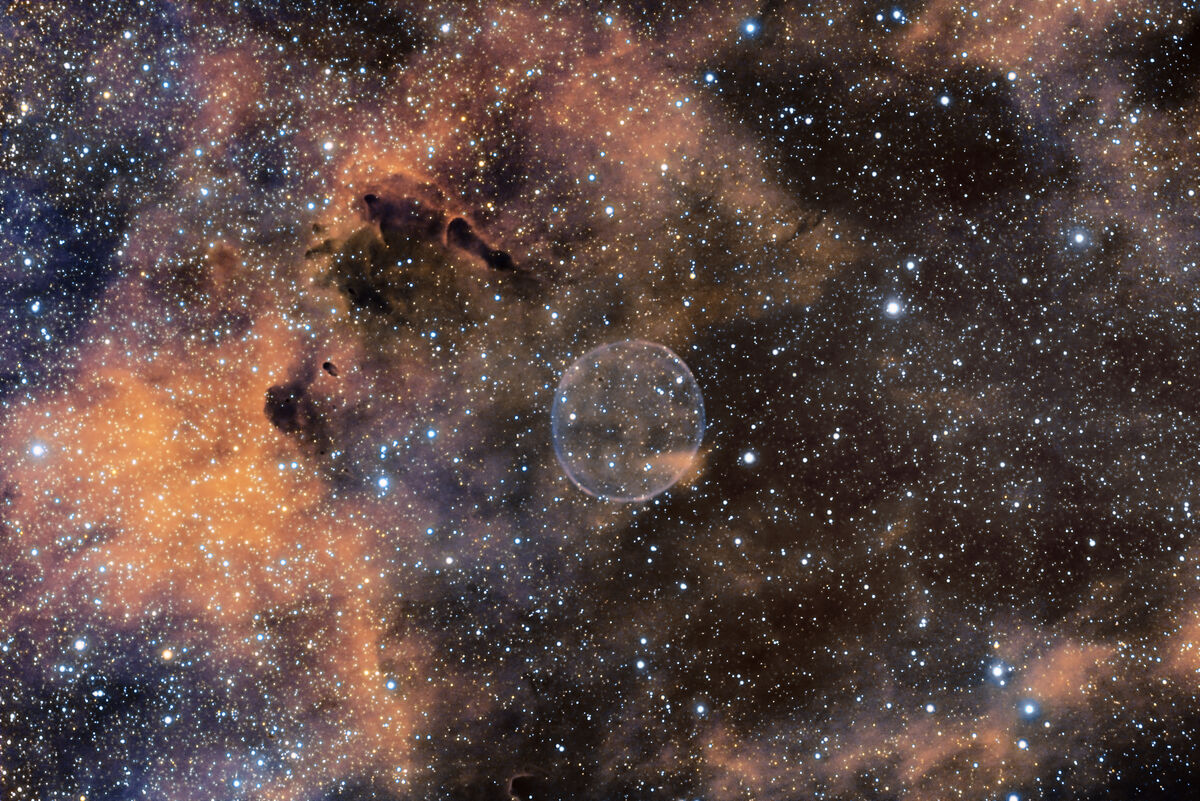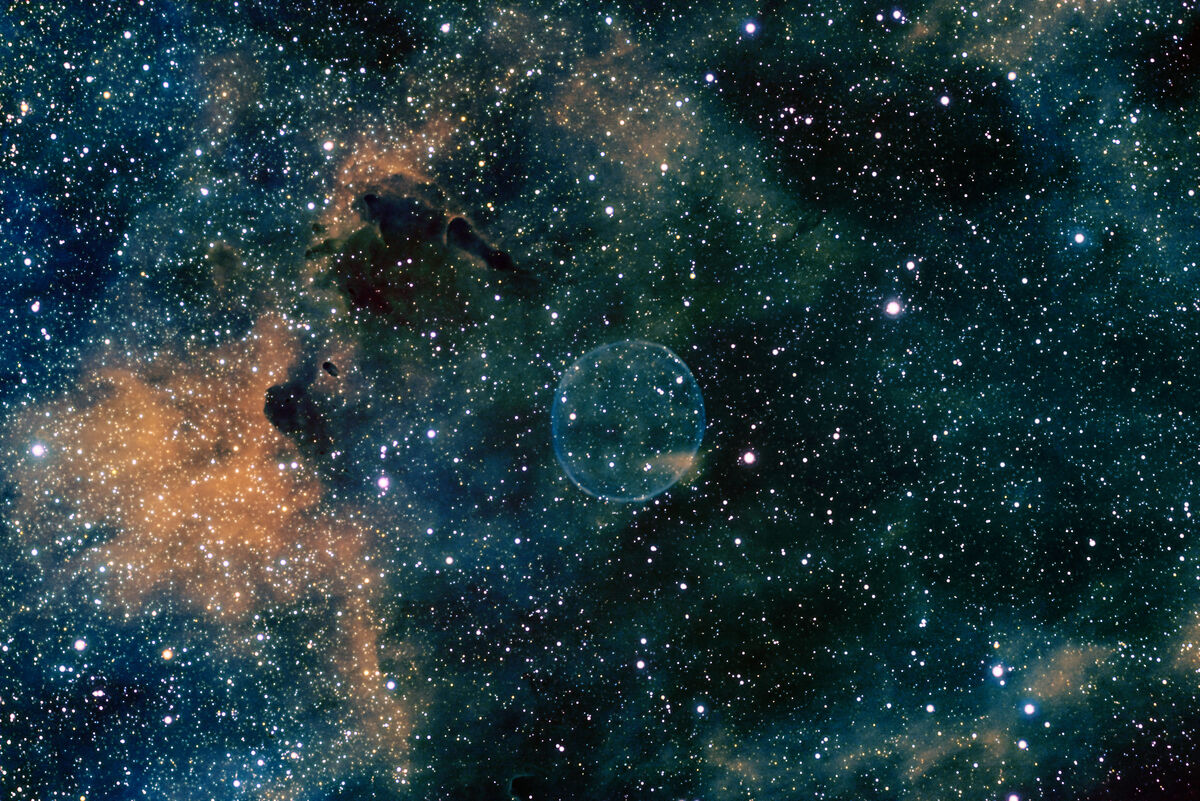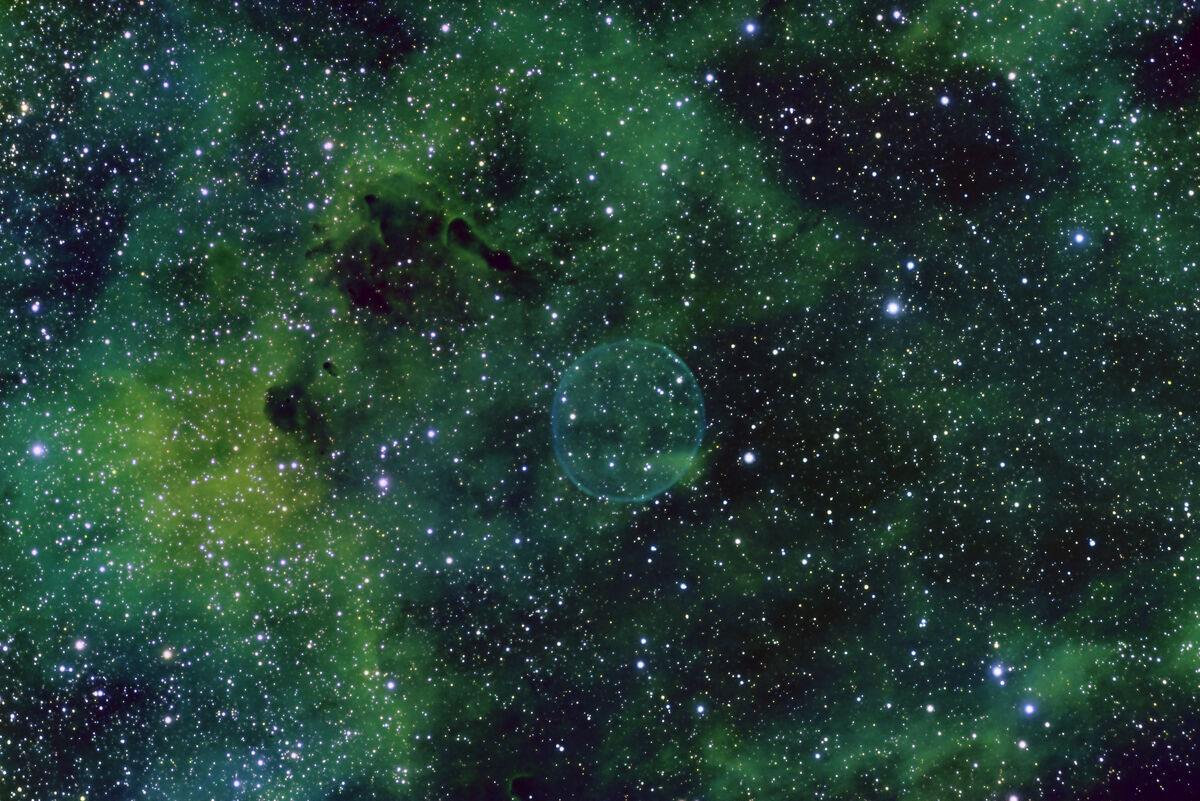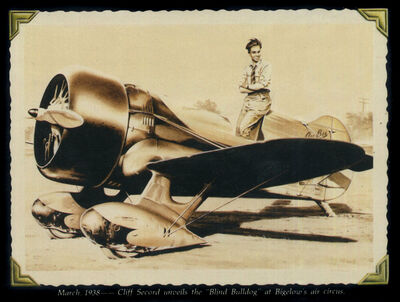The Soap Bubble Nebula
Jul 29, 2023 02:32:24 #
Ballard
Loc: Grass Valley, California
This object is a very spherically symmetric planetary nebula, or else a very large alien force field. The Soap Bubble nebula can be found in the constellation of Cygnus the Swan (also known as the Northern Cross) and not far from the Crescent Nebula see https://www.uglyhedgehog.com/t-750090-1.html.
The distance to the Soap Bubble Nebula is estimated to be 4000 lights and since it is only 4 arcminutes across it has an actual diameter of approximately 5 light-years. The central star of this planetary nebula has a magnitude of 19.75 which is very dim as is the Soap Bubble itself.
The first image was made using a Narrow Band Hydrogren Alpha (Ha) filter for the luminance and for the Red Channels, a Green filter was used for the Green Channel and a Narrow Band Oxygen 3 (O3) filter was used for the Blue channel.
The Second image added in Narrow Band Sulfur 2 (S2) Data to the red channel using filter the Narrowband Combination routine in pixinght which shifted the color a bit.
The last image was made using the Hubble pallet with S2 for the Red Channel, Ha for the Green Channel and O3 for the Blue channel.
All questions, comments and suggestions are welcome
This is a tough object to image as it only showed up in the Ha and O3 data and it took a lot of exposure time.
For those interested all images were taken with a 16 inch Meade LX200 Schmidt Cassegrain telescope with a focal length of 4064 mm. The camera used was an ASI 6400MM pro monochrome camera with the temperature set to -12 C, binning set to 1x1, and gain set to 100. All appropriate Flats, dark and bias frames were used for image calibration.
The following exposures where use to capture the data. (The somewhat odd numbers are due to throwing out a few of the frames when the seeing fuzed out a bit causing the FWHM (Full width at half maximum) of the stars to get a bit bigger than the other frames.)
Green 61 frames each 2 minutes long
Ha 79 frames each 500 seconds long
O3 78 frames each 500 seconds long
S2 77 frames each 500 seconds long
Total exposure time 34 hours 32 minutes.
The distance to the Soap Bubble Nebula is estimated to be 4000 lights and since it is only 4 arcminutes across it has an actual diameter of approximately 5 light-years. The central star of this planetary nebula has a magnitude of 19.75 which is very dim as is the Soap Bubble itself.
The first image was made using a Narrow Band Hydrogren Alpha (Ha) filter for the luminance and for the Red Channels, a Green filter was used for the Green Channel and a Narrow Band Oxygen 3 (O3) filter was used for the Blue channel.
The Second image added in Narrow Band Sulfur 2 (S2) Data to the red channel using filter the Narrowband Combination routine in pixinght which shifted the color a bit.
The last image was made using the Hubble pallet with S2 for the Red Channel, Ha for the Green Channel and O3 for the Blue channel.
All questions, comments and suggestions are welcome
This is a tough object to image as it only showed up in the Ha and O3 data and it took a lot of exposure time.
For those interested all images were taken with a 16 inch Meade LX200 Schmidt Cassegrain telescope with a focal length of 4064 mm. The camera used was an ASI 6400MM pro monochrome camera with the temperature set to -12 C, binning set to 1x1, and gain set to 100. All appropriate Flats, dark and bias frames were used for image calibration.
The following exposures where use to capture the data. (The somewhat odd numbers are due to throwing out a few of the frames when the seeing fuzed out a bit causing the FWHM (Full width at half maximum) of the stars to get a bit bigger than the other frames.)
Green 61 frames each 2 minutes long
Ha 79 frames each 500 seconds long
O3 78 frames each 500 seconds long
S2 77 frames each 500 seconds long
Total exposure time 34 hours 32 minutes.
Soap Bubble Nebula using Ha for luminance and Red Channels, Green for the Channel and O3 for the Blue channel

(Download)
Soap Bubble Nebula adding in S2 to Red Channel with the NBRGB Combination routine

(Download)
Soap Bubble Nebula using the Hubble Pallet.

(Download)
Jul 29, 2023 07:28:22 #
Jul 29, 2023 10:57:23 #
Ballard
Loc: Grass Valley, California
SkyKing wrote:
…truly amazing work here…beautifully done…!
Hi SkyKing
Thanks for checking out the image of the Soap Bubble Nebula and for the comment.
Jul 29, 2023 15:57:04 #
Jul 29, 2023 16:19:47 #
Ballard
Loc: Grass Valley, California
tony85629 wrote:
Outstanding work, both capture and processing.
Hi tony85629
Thanks for viewing the photos of The Soap Bubble nebula and for the comment.
Jul 29, 2023 17:22:30 #
Ballard wrote:
This object is a very spherically symmetric planet... (show quote)
Yup, a VERY large alien force field BUT you captured it very nicely.
bwa
Jul 29, 2023 17:54:56 #
Ballard
Loc: Grass Valley, California
bwana wrote:
Yup, a VERY large alien force field BUT you captured it very nicely.
bwa
bwa
Hi bwa
Thanks for checking out the shot of the Soap Bubble Nebula and for the comment.
Jul 30, 2023 09:11:25 #
Jul 30, 2023 12:36:54 #
Ballard
Loc: Grass Valley, California
LoisCroft wrote:
So beautiful. What a talented photographer!
Hi LoisCroft
Thanks for viewing the Soap Bubble Nebula and for the comment.
Jul 31, 2023 05:07:42 #
Jul 31, 2023 13:42:39 #
Ballard
Loc: Grass Valley, California
Marc G wrote:
Very nice work mate
Hi Marc G
Thanks for checking out the photos of the Soap Bubble Nebula and for the comment.
Aug 3, 2023 08:32:10 #
That's awesome, the color combinations give the image a lot of depth when combined. Ballard, processing is spot on.
Aug 3, 2023 11:23:37 #
Amazing work there, Ballard! 


Incredibly sharp.
I find myself going for longer exposures again. Typically 300 seconds in my narrowband filters. But my pet for LRGB is 180 seconds currently.
Your LS200 must be in excellent cumulation. I'm glad you explained the image numbers, the 77, 78, 79 had me craning my neck in wonder.
I would share your thought about the force field. Your images show the bubble is perfectly clear. There is so much out there we will never understand or know.



Incredibly sharp.
I find myself going for longer exposures again. Typically 300 seconds in my narrowband filters. But my pet for LRGB is 180 seconds currently.
Your LS200 must be in excellent cumulation. I'm glad you explained the image numbers, the 77, 78, 79 had me craning my neck in wonder.
I would share your thought about the force field. Your images show the bubble is perfectly clear. There is so much out there we will never understand or know.

Aug 4, 2023 01:23:11 #
Ballard
Loc: Grass Valley, California
stepping beyond wrote:
That's awesome, the color combinations give the image a lot of depth when combined. Ballard, processing is spot on.
Hi stepping beyond
Thank you for viewing the image of the Soap Bubble Nebula and for the comment. I experimented with the color channel combinations and liked the first one the best.
Aug 4, 2023 01:49:45 #
Ballard
Loc: Grass Valley, California
SonnyE wrote:
Amazing work there, Ballard! img src="https://st... (show quote)
Hi SonnyE
Thank you for checking out the image of the Soap Bubble Nebula and for the comment. Before I shot the images I normally do a test run to see what the histogram looks like to make sure that I don't get too many pixels fully saturated (65535 counts with my 16 bit camera). If you do saturate all the colors then those areas come out white and you lose the color information. So when I see this in the histogram I back down the exposure time and take more exposures to stack. When they are added with the stacking softwareI usually use a 32 bit floating point stack and get a large dynamic range and can still get the colors out on all but some of the brightest stars that saturated a few of the pixels in the subframe, and even then the halo/bloat from the larger number of scattered photons on bright stars still gets the color in all but their center area which turns white. Depending in the image I will use 30 second to 3 minutes on the luminance, 1 minutes to 5 minutes on the color filters. The narrow band do require more, I typically use 5 minutes and up to 15 minute exposures on these again depending on the image.
I have been pleased that the LX200 as it seems to stay very well collimated even after traveling around a bit and haven't needed to collimate it since last year. A while back I got some Bob's Knobs for the scope and it makes it easy to collimate particularly when I can watch the laptop screen with the camera taking continuous shots while tweaking the knobs. I plan to take the corrector plate off pretty soon and clean it has it has accumulated a lot of dust that doesn't blow off with the camera dust blower and I will probably need to re-collimate it again after cleaning and reinstallation.
It is amazing how spherically symmetric the Soap Bubble Nebula is (Hence the comment about the force field).
If you want to reply, then register here. Registration is free and your account is created instantly, so you can post right away.


